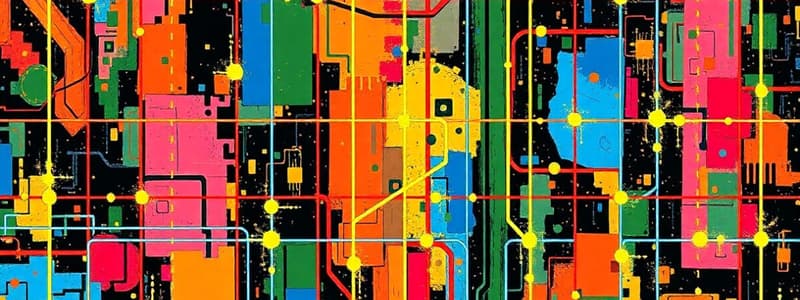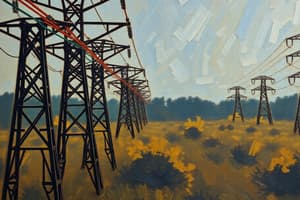Podcast
Questions and Answers
What is a key aspect of connection requirements in grid code technical requirements?
What is a key aspect of connection requirements in grid code technical requirements?
- Backup power systems
- Energy storage technologies
- Voltage levels specification (correct)
- Renewable energy incentives
Which operational requirement ensures equipment maintains acceptable voltage quality?
Which operational requirement ensures equipment maintains acceptable voltage quality?
- Transmission line inspections
- Emergency response procedures
- Harmonic distortion standards (correct)
- Generation capacity monitoring
What is the purpose of protection coordination in safety and protection requirements?
What is the purpose of protection coordination in safety and protection requirements?
- To ensure selective tripping of faulty equipment (correct)
- To regulate power purchase agreements
- To enhance energy trading
- To prevent grid expansion
Which of the following is included in grid operation and control requirements?
Which of the following is included in grid operation and control requirements?
What type of services are outlined under grid support services in operational requirements?
What type of services are outlined under grid support services in operational requirements?
Which procedure is crucial in verifying compliance with grid code requirements?
Which procedure is crucial in verifying compliance with grid code requirements?
What is a primary focus of grid code compliance and testing?
What is a primary focus of grid code compliance and testing?
Which aspect is covered under the grid code technical requirements in relation to frequency?
Which aspect is covered under the grid code technical requirements in relation to frequency?
What is the primary reason solar PV systems disconnect from the grid during significant voltage dips?
What is the primary reason solar PV systems disconnect from the grid during significant voltage dips?
Which of the following describes the maximum frequency operating limit?
Which of the following describes the maximum frequency operating limit?
What power quality issue results in a complete loss of voltage for a short duration?
What power quality issue results in a complete loss of voltage for a short duration?
Which term describes the capability of wind turbines to tolerate short-term voltage dips?
Which term describes the capability of wind turbines to tolerate short-term voltage dips?
What is a consequence of operating electrical equipment outside the specified voltage and frequency limits?
What is a consequence of operating electrical equipment outside the specified voltage and frequency limits?
Which of the following is a common method to mitigate power quality issues?
Which of the following is a common method to mitigate power quality issues?
Which class of power quality issue is characterized by non-linear loads that distort the waveform?
Which class of power quality issue is characterized by non-linear loads that distort the waveform?
During grid outages, what is a necessary safety measure for both solar PV and wind farms?
During grid outages, what is a necessary safety measure for both solar PV and wind farms?
In which scenarios are voltage operating limits crucial?
In which scenarios are voltage operating limits crucial?
What is the typical nominal voltage for household appliances in many regions?
What is the typical nominal voltage for household appliances in many regions?
Which frequency operating limit is defined as the standard frequency for optimal equipment function?
Which frequency operating limit is defined as the standard frequency for optimal equipment function?
What is a common cause of voltage sags in power systems?
What is a common cause of voltage sags in power systems?
Why is compliance with voltage and frequency limits vital for electrical equipment?
Why is compliance with voltage and frequency limits vital for electrical equipment?
What is a potential effect of operating equipment during frequency variations?
What is a potential effect of operating equipment during frequency variations?
What is the primary purpose of fault ride-through (FRT) requirements for wind farms?
What is the primary purpose of fault ride-through (FRT) requirements for wind farms?
What do low voltage ride-through (LVRT) requirements dictate?
What do low voltage ride-through (LVRT) requirements dictate?
Which aspect is NOT a consideration for reactive power regulation in wind farms?
Which aspect is NOT a consideration for reactive power regulation in wind farms?
What is typically required of wind farms during frequency ride-through (FRT) conditions?
What is typically required of wind farms during frequency ride-through (FRT) conditions?
What defines the voltage operating limits for wind farms?
What defines the voltage operating limits for wind farms?
What is one important reason for the periodic updating of grid code technical requirements?
What is one important reason for the periodic updating of grid code technical requirements?
How should wind farms respond during high voltage ride-through (HVRT) conditions?
How should wind farms respond during high voltage ride-through (HVRT) conditions?
What is a primary requirement for wind farms regarding testing and verification before grid connection?
What is a primary requirement for wind farms regarding testing and verification before grid connection?
Which of the following is NOT included in the requirements for real power regulation?
Which of the following is NOT included in the requirements for real power regulation?
What is the significance of maintaining real and reactive power regulation in wind farms?
What is the significance of maintaining real and reactive power regulation in wind farms?
Why is compliance with grid code requirements vital for the operation of electricity grids?
Why is compliance with grid code requirements vital for the operation of electricity grids?
What challenge is specifically addressed by energy storage systems in relation to renewable energy integration?
What challenge is specifically addressed by energy storage systems in relation to renewable energy integration?
Which of the following is an incorrect statement regarding frequency operating limits for wind farms?
Which of the following is an incorrect statement regarding frequency operating limits for wind farms?
What is the primary advantage of hybrid solar PV and wind systems?
What is the primary advantage of hybrid solar PV and wind systems?
Which region is primarily known for the extensive interconnections that facilitate electricity exchange among neighboring countries?
Which region is primarily known for the extensive interconnections that facilitate electricity exchange among neighboring countries?
What challenge is commonly associated with hybrid and isolated operations of solar PV and wind systems?
What challenge is commonly associated with hybrid and isolated operations of solar PV and wind systems?
What is a significant factor that influences the success of power system interconnections?
What is a significant factor that influences the success of power system interconnections?
In which situation would isolated solar PV and wind systems be most beneficial?
In which situation would isolated solar PV and wind systems be most beneficial?
What is a key operational characteristic of the Nordic Countries' energy cooperation?
What is a key operational characteristic of the Nordic Countries' energy cooperation?
Which of the following projects aims to integrate remote renewable energy resources into major demand centers in Australia?
Which of the following projects aims to integrate remote renewable energy resources into major demand centers in Australia?
Which major interconnected grid in North America is known to operate independently of the others?
Which major interconnected grid in North America is known to operate independently of the others?
How do hybrid systems contribute to stabilizing the power grid?
How do hybrid systems contribute to stabilizing the power grid?
What major geographical advantage does China leverage in expanding its power grid?
What major geographical advantage does China leverage in expanding its power grid?
Which of the following benefits is NOT associated with isolated solar PV and wind systems?
Which of the following benefits is NOT associated with isolated solar PV and wind systems?
What is a common outcome of establishing interconnections in the MENA region?
What is a common outcome of establishing interconnections in the MENA region?
Which of the following is a primary characteristic of remote microgrids?
Which of the following is a primary characteristic of remote microgrids?
Which factor is essential in the design of hybrid and isolated renewable energy systems?
Which factor is essential in the design of hybrid and isolated renewable energy systems?
Flashcards are hidden until you start studying
Study Notes
Grid Code Technical Requirements
- Grid codes are sets of regulations and standards for connecting, operating, and behaving electrical generation and consumption equipment on a grid.
- They guarantee the safe, efficient, and reliable operation of the whole grid (transmission and distribution).
Connection Requirements
- Grid codes define voltage levels for connecting equipment (generators, consumers) to the grid.
- Frequency tolerances and the ability of connected equipment to synchronize with grid frequency are outlined.
- Standards for physical connection to the grid ensure compatibility and safety.
Operational Requirements
- Power quality standards maintain voltage regulation, harmonics, flicker, and transient response within limits.
- Grid stability is supported by reactive power support, frequency response, and voltage control.
- Grid support services include frequency regulation, voltage support, and black start capability.
Safety and Protection
- Protection coordination ensures selective tripping and isolation of faulty equipment without widespread outages.
- Safety standards address electrical hazards, grounding requirements, and islanding prevention.
Grid Operation and Control
- Generation sources require controllability and dispatchability, including ramp rates, output flexibility, and response to commands.
- Data and communication protocols facilitate grid monitoring, control, and optimization.
Grid Code Compliance and Testing
- Verification and certification procedures confirm compliance before equipment connection or commissioning.
- Testing requirements specify equipment and system testing under operating conditions.
Evolving Requirements
- Integration of renewable energy requires adaptations, including grid stability during variable generation and energy storage.
- Smart grid technologies and advanced metering infrastructure (AMI) are being integrated for enhanced grid flexibility and efficiency.
Fault Ride-Through for Wind Farms
- Fault ride-through (FRT) requirements for wind farms ensure grid stability during grid faults or disturbances.
- Wind farms must remain connected and supply/absorb power during abnormal grid conditions.
Voltage Ride-Through
- Low Voltage Ride-Through (LVRT): Maintain connection and supply power when grid voltage drops below a threshold (15% to 85% of nominal voltage).
- High Voltage Ride-Through (HVRT): Withstand overvoltage conditions caused by grid faults without disconnecting.
Frequency Ride-Through (FRT)
- Wind farms must operate within specified frequency ranges during grid disturbances.
- Adjustments to output help stabilize frequency deviations caused by load changes or disturbances.
Real and Reactive Power Regulation
- Active power control involves adjusting wind farm output to support grid stability and balance supply and demand.
- Reactive power capability may be needed to maintain voltage stability and support other grid-connected equipment.
Voltage and Frequency Operating Limits
- Wind farms must operate within specific voltage ranges for safe and efficient electricity delivery, set for steady-state and transient conditions.
- Wind farms actively participate in frequency regulation, adjusting output to restore grid frequency to its nominal value.
Solar PV and Wind Farm Behaviour during Grid Disturbances
- Solar PV systems typically disconnect from the grid during significant voltage dips.
- They don't actively stabilize grid frequency unless advanced inverters with active power control capabilities are used.
- Without grid support or energy storage, solar PV systems cannot operate during grid outages.
- Wind turbines have voltage ride-through capabilities and can continue to operate during short-term voltage dips.
- Wind turbines can provide frequency support through frequency response adjustments (adjusting output based on grid frequency changes).
- Like solar PV, wind turbines disconnect from the grid during extended outages to prevent islanding.
Power Quality Issues
- Power quality refers to deviations from ideal electrical supply conditions impacting equipment operation.
- These issues include voltage sag (dip), voltage swell, voltage interruption, voltage imbalance, harmonic distortion, transient voltages, and frequency variations.
- These issues can arise from factors such as lightning strikes, switching loads, power system faults, and non-linear loads.
- Power quality problems can cause equipment malfunction, damage, data loss, and increased energy consumption.
- Power quality monitoring, surge protectors, voltage regulators, and harmonic filters mitigate these issues.
Power System Interconnection Experiences Worldwide
- The EU has a network of interconnected power systems, facilitating renewable energy integration and balancing supply and demand on a continental scale.
- Nordic countries have extensive cross-border interconnections for trade, hydropower optimization, and enhanced stability.
- North America has three major interconnected grids enabling resource sharing, supply-demand balancing, and emergency support.
- Australia is expanding interconnections for reliability and renewable energy integration, with projects like Renewable Energy Zones (REZs) connecting remote resources to demand centers.
- China is expanding its grid and interconnections for economic growth and renewable energy integration from remote areas to population centers.
- South America has interconnection networks for electricity exchange and mutual support during high demand or disruptions.
- MENA countries are exploring interconnections to harness solar power and share resources across borders.
Hybrid and Isolated Operations of Solar PV and Wind Systems
- Hybrid systems combine solar PV and wind turbines for maximized energy output and intermittency complementation.
- Benefits include enhanced reliability, optimized resource use, and grid support capabilities.
- Hybrid solar-wind farms are increasingly being deployed globally.
- Isolated systems operate independently from the grid, often in remote locations where grid connection is impractical.
- Types include remote microgrids and stand-alone systems.
- Benefits include energy access, resilience, and cost savings compared to grid extension.
- Challenges and considerations include intermittency, system design, and grid integration.
Studying That Suits You
Use AI to generate personalized quizzes and flashcards to suit your learning preferences.





